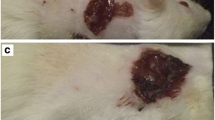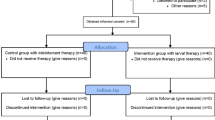Abstract
Larval therapy consists on the application of sterilized carrion flies larvae, reared in laboratory, on acute, chronic, and/or infected wounds in order to promote healing. Conventional methods for treating injuries include mechanical debridement or silver-based dressings; however, they are not always effective for wound healing. Larval therapy is a feasible and safe treatment for therapeutic application and, in many cases, the only and the most recommended alternative for difficult healing injuries. Thus, this study aimed to evaluate the competence of Cochliomyia macellaria F. (Diptera: Calliphoridae) as a suitable species for therapeutic application and evaluate time and effectiveness of the types of treatments most commonly used to treat integumental injuries. C. macellaria eggs were obtained from colonies established in laboratory and sterilized prior to application. Twenty-five larvae were applied for each centimeter squared of lesion. Lesions were induced in 24 Wistar rats; type 1 diabetes mellitus was induced in 12 of them. Animals were divided in four groups with three individuals each, being denominated: larval therapy, larval therapy associated with foam dressing with silver release, mechanical debridement with foam dressing silver and control group, without treatment. All treatments were applied once and held for 24 h. Medical application of larvae was found to be safe, as only dead tissue was removed, and efficient to accelerate healing process when compared to other treatments.

Similar content being viewed by others
References
Abdelrahman T, Newton H (2011) Wound dressings—principles and practice. Surgery 29:491–495
Akinola O, Gabriel M, Suleiman AA, Olorunsogbon F (2012) Treatment of alloxan-induced diabetic rats with metformin or glitazones is associated with amelioration of hyperglycaemia and neuroprotection. Open Diabetes J 5:8–12
Arora S, Sing LC, Baptista C (2010) Antibacterial activity of Lucilia cuprina maggot extracts and its extraction techniques. IJIB 9:43–48
Barnes KM, Gennard DE, Dixon RA (2010) An assessment of the antibacterial activity in larval excretion/secretion of four species of insects recorded in association with corpses, using Lucilia sericata Meigen as the marker species. B Entomol R 100:635–640
Bexfield A, Bond E, Morgan C, Wagstaff J, Newton RP, Ratcliffe NA, Dudley E, Nigam Y (2009) Amino acid derivatives from Lucilia sericata excretions⁄secretions may contribute to the beneficial effects of maggot therapy via increased angiogenesis. Brit J Dermatol 162:554–562
Bjarnsholt T, Kirketerp-MØller K, Jensen PØ, Madsen KG, Phipps R, Krogfelt K, HØiby N, Givskov M (2007) Why chronic wounds will not heal: a novel hypothesis. Wound Repair Regen 16:2–10
Bohova J, Majtan J, Takac P (2012) Immunomodulatory properties of medicinal maggots Lucilia sericata in wound healing process. Tang 2:1–7
Borges EL, Chianca TCM (2000) Tratamento e cicatrização de feridas—Parte I. Nurs 21:24–29
Cândido LC (2001) Nova abordagem no tratamento de feridas. SENAC São Paulo, São Paulo
Cazander G, Gottrup F, Jukema GN (2009) Maggot therapy for wound healing: clinical relevance, mechanisms of action and future prospects. J Wound Technol 5:18–23
Cazander G, Pritchard DI, Nigam I, Jung W, Nibbering PH (2013) Multiple actions of Lucilia sericata larvae in hard-to-heal wounds. Bioessays 35:1083–1092
Chambers L, Woodrow S, Brown A (2003) Degradation of extracellular matrix components by defined proteinases from the greenbottle larva—Lucilia sericata used for the clinical debridement of non-healing wounds. Brit J Dermatol 148:14–23
Chan DCW, Fong DHF, Leung JYY, Patil NG, Leung GKK (2007) Maggot debridement therapy in chronic wound care. Hong Kong Med J 13:382–386
Corsi RCC, Corsi PR, Pirana S, Muraco FAE, Jorge D (1995) Fatores que prejudicam a cicatrização das feridas: revisão da literatura. Rev Bras Cir 85:47–53
Deodhar AK, Rana RE (1997) Surgical physiology of wound healing: a review. J Postgrad Med 43:52–56
Church JCT (1999) Larva therapy in modern wound care: a review. Primary Intent 1:63–68
Courtenay M, Church JCT, Ryan TJ (2000) Larva therapy in wound management. J R Soc Med 93:72–74
Erdmann GR, Khalil SK (1986) Isolation and identification of two antibacterial agents produced by a strain of Proteus mirabilis isolated from larvae of the screwworm (Cochliomyia hominivorax) (Diptera: Calliphoridae). J Med Entomol 23:208–211
Eskelinen E, Lepäntalo M, Hietala EM, Sell H, Kauppila L, Mäenpää I, Pitkänen J, Salminen-Peltola P, Luetola S, Eskelinen A, Kivioja A, Tukiainen E, Lukinmaa A, Brasken P, Railo M (2004) Lower limb amputations in southern Finland in 2000 and trends up to 2001. Eur J Vasc Endovasc Surg 27:193–200
Eurides D, Mazzanti A, Belleti MA, Silva LAF, Fioravante MCS, Troncoso NS, Campos VA, Lemos RC, Silvestrini PL (1996) Morfologia e Morfometria da Reparação Tecidual de Feridas Cutâneas de Camundongos Tratadas com Solução Aquosa de Barbatimão (Stryphynodendron Barbatiman Martius). Rev VZVA 2:30–40
Figueroa L, Uherek F, Yusef P, López L, Flores J (2006) Experiencia de terapia larval en pacientes con úlceras crônicas. Parasitol Latinoam 61:160–164
Grella MD, Thyssen PJ (2011) Chave taxonômica interativa para espécies de dípteros califorídeos (Infraordem: Muscomorpha) do Brasil. http://keys.lucidcentral.org/keys/v3/calliphoridae_brazil. Accessed 09 November 2014.
Harkness J, Wagner J (1993) Biologia e Clínica de Coelhos e Roedores, 3rd edn. Roca, São Paulo, pp 90–91
Lenzen S (2008) The mechanisms of alloxan and streptozotocin induced diabetes. Diabetologia 51:216–226
Lukens FDW (1948) Alloxan diabetes. Physiol Rev 28:304–330
Meneghin P, Vattimo MFF (2003) Fisiopatologia do processo cicatricial. In: Jorge AS (ed) Abordagem multiprofissional do tratamento de feridas, 1st edn. Atheneu, São Paulo, pp 31–42
Moretti TC, Thyssen PJ, Solis DR (2009) Breeding of the Scuttle Fly Megaselia scalaris in a fish Carcass and Implications for the use in Forensic Entomology (Diptera: Phoridae). Entomol Gen 31:349–353
Mudge E, Price P, Neal W, Harding KG (2013) A randomized controlled trial of larval therapy for the debridement of leg ulcers: results of a multicenter, randomized, controlled, open, observer blind, parallel group study. Wound Rep Reg 22:43–51
Nassu MP, Thyssen PJ (2015) Evaluation of larval density Cochliomyia macellaria F. (Diptera: Calliphoridae) for therapeutic use in the recovery of tegumentar injuries. Parasitol Res 114:3255–3260
Nigam Y, Bexfield A, Thomas S, Ratcliffe NA (2006) Maggot therapy—the science and implication for CAM Part I—History and bacterial resistance. eCAM 3:223–227
Nitsche MJT (2010) Avaliação da recuperação de lesões cutâneas por meio de terapia larval utilizando como modelos ratos Wistar. Dissertation, Universidade Estadual Paulista. http://www.ibb.unesp.br/posgrad/teses/bga_do_2010_maria_nitsche.pdf. Accessed 22 November 2015
Oliveira HP (1992) Traumatismos nos animais domésticos. Cad Téc Esc Vet 1:01–57
Pinheiro MARQ, Ferraz JB, Junior MAA, Moura AD, Costa MESM, Costa FJMD, Neto VFA, Neto RM, Gama RA (2015) Use of maggot therapy for treating a diabetic foot ulcer colonized by multidrug resistant bacteria in Brazil. Indian J Med Res 141:340–342
Prazeres SJ (2009) Tratamento de feridas: Teoria e Prática. Moriá, Porto Alegre
Prete PE (1997) Growth effects of Phaenicia sericata larval extracts on fibroblasts: mechanism for wound healing by maggot therapy. Life Sci 60:505–510
Sherman RA, Hall MJ, Thomas S (2000) Medicinal maggots: an ancient remedy for some contemporary afflictions. Annu Rev Entomol 45:55–81
Singer AJ, Clark RAF (1999) Cutaneous wound healing. New Engl J Med 341:738–746
Thyssen PJ, Nassu MP, Nitsche MJT, Leite D (2013) Sterilization of immature blowflies (Calliphoridae) for use in larval therapy. J Med Sci 4:405–409
Author information
Authors and Affiliations
Corresponding author
Ethics declarations
Ethical aspects
The whole experiment was performed according to the Ethics Committee for Experimentation (CEEA) of 2 April 2014 (No. 9167 protocol).
Rights and permissions
About this article
Cite this article
Masiero, F.S., Thyssen, P.J. Evaluation of conventional therapeutic methods versus maggot therapy in the evolution of healing of tegumental injuries in Wistar rats with and without diabetes mellitus. Parasitol Res 115, 2403–2407 (2016). https://doi.org/10.1007/s00436-016-4991-8
Received:
Accepted:
Published:
Issue Date:
DOI: https://doi.org/10.1007/s00436-016-4991-8




